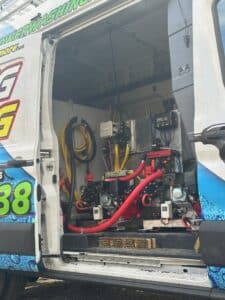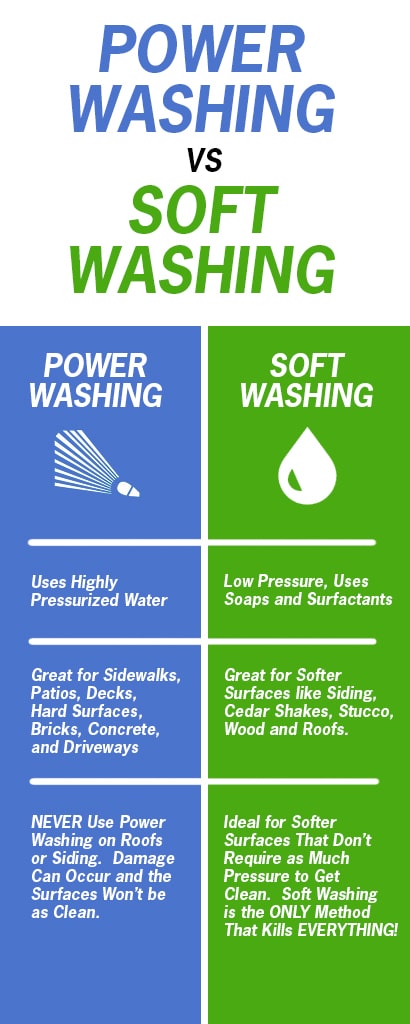Power Washing vs Soft Washing

Power washing, also known as pressure washing, uses a high-pressure stream of water to blast away dirt and grime from surfaces. The high-pressure stream can be adjusted depending on the surface being cleaned, but it is generally used on harder surfaces like concrete, brick, and stone.
Soft washing, on the other hand, uses a low-pressure stream of water combined with cleaning agents to clean surfaces. Soft washing typically uses a pressure of 175 psi and is used on more delicate surfaces like siding, vinyl, stucco, wood, and painted surfaces.
Choosing the right method depends on the surface being cleaned, the type of contaminants present, and the level of cleaning required.
Call or Text Today!
 Power Washing
Power Washing
Power washing is an effective method of cleaning harder surfaces like concrete, brick, and stone. It can remove stubborn stains and dirt from surfaces quickly and efficiently. Power washing is also effective at removing mold and mildew from surfaces, which can be a health hazard if left untreated.
One of the biggest advantages of power washing is its speed. With the high-pressure stream of water, power washing can clean large surfaces in a short amount of time. It is also a relatively simple process, which makes it ideal for DIY projects.
However, power washing can also be dangerous if not used properly. The high-pressure stream of water can cause damage to surfaces like wood, paint, and softer materials. It can also be hazardous to the user if not handled with care. The high-pressure stream of water can cause injuries like cuts, bruises, and even broken bones.
Soft Washing:
Soft washing is a gentler method of cleaning surfaces and is ideal for more delicate surfaces like stucco, wood, and painted surfaces. Soft washing uses a low-pressure stream of water combined with cleaning agents to remove dirt, grime, and other contaminants from surfaces. The cleaning agents used in soft washing are designed to be environmentally friendly and biodegradable.
One of the biggest advantages of soft washing is that it is gentle on surfaces. It can effectively remove dirt and grime without damaging the surface being cleaned. Soft washing is also an effective method of cleaning roofs, which can be damaged by power washing.
Soft washing can be a slower process compared to power washing, as it requires time for the cleaning agents to work. It also requires a bit more skill to use, as the pressure and cleaning agents need to be adjusted depending on the surface being cleaned.
One of the drawbacks of soft washing is that it may not be as effective at removing stubborn stains and contaminants as power washing. It also requires the use of cleaning agents, which can be harmful to plants and other wildlife if not used properly.
Which Method is Best?
Choosing the best method of cleaning depends on a variety of factors. The type of surface being cleaned, the level of cleaning required, and the type of contaminants present are all important factors to consider.
If you are cleaning a harder surface like concrete, power washing may be the better option. Power washing is effective at removing stubborn stains and dirt quickly and efficiently. It is also ideal for removing mold and mildew from surfaces.
If you are cleaning a more delicate surface like stucco, wood, or painted surfaces, soft washing may be the better option. Soft washing is gentler on surfaces and can effectively remove dirt and grime without damaging the surface

 Power Washing
Power Washing